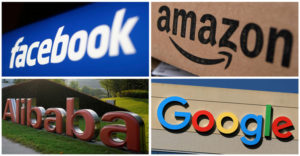
BERLIN/CHICAGO – People with hay fever hate dust. That was the premise of a marketing drive launched by British vacuum cleaner maker Dyson with U.S. retailer Target Corp.
Using data about its customers’ shopping habits, Target homed in on shoppers who likely had allergies and showed them ads for Dyson’s cordless V6 vacuum on social media and Target’s website. The result: sales for the vacuums doubled among shoppers who regularly purchase anti-allergy treatments and products such as Claritin or humidifiers on Target.com and in stores.

Data about real people and real behaviors “actually get a much stronger result because the fidelity of that data is so much richer,” said Kristi Argyilan, Target’s senior vice president of media and guest engagement.
Retailers ranging from Target and Walmart Inc to grocers such as Tesco Plc are working aggressively to attract big advertisers to their websites in a bid to drive sales, according to interviews with retailers, packaged goods makers, consumer data firms and marketing consultants.
Specifically, they are selling more ad space, pop-up banners and search-bar keywords to consumer goods companies such as Kraft Heinz Co and Procter & Gamble Co. These makers of everything from soup to shampoo are investing more to advertise on retailers’ websites where people who already have an intent to buy are guided to specific products using their individual shopping habits.
This online ad revenue offers significantly higher margins for retailers than selling goods in stores.
By carving out a space for themselves in the booming digital ad market, they are taking on Alphabet Inc’s Google and Facebook Inc and the $114 billion they received last year in global online ad revenue. According to research company eMarketer, Google and Facebook’s revenue accounted for nearly half of the global market in 2017.
Supermarkets have long charged brands to place products in the busiest parts of their stores, such as near the checkout counter.
As more shopping shifts online, e-commerce giants Amazon.com Inc and Alibaba Group Holding Ltd pioneered replicating that strategy on their websites by mining data to target advertising at selected customers or groups. Amazon ad revenue alone could jump to $6.6 billion by 2019 from $2.8 billion last year, according to JPMorgan.
While retailers have a long way to go before they come close to Google and Facebook digital advertising prowess, their instant access to data on what is selling puts stores in a strong position, said Joe Zawadzki, chief executive of MediaMath, which helps brands manage ad campaigns.
“To the extent that the retailer can help the manufacturer, it becomes a new revenue opportunity and a way forward for them,” he said. “We’re very much at the start of this.”
Alphabet and Facebook declined to comment. To be sure, retailers and brands for the foreseeable future will still be drawn to advertise with Facebook and Google given the internet giants’ massive customer base in order to drive traffic to their websites. And the Silicon Valley companies likely will make overtures to long-time clients of theirs to avoid losing business.
BANNERS, POP-UPS AND MONEY BACK
Retailers are offering a range of marketing options online, including banner ads, pop-ups and money-off deals. As with Google, suppliers can pay for keywords to get their products listed at the top of any search.
Some industry observers expect voice aides like Amazon’s Alexa may one day let brands pay to be the first product recommended when a shopper asks to purchase an item such as ketchup, a feature known as “Amazon’s Choice.” Amazon told Reuters it has no plans to let companies pay for the distinction, “nor do we have plans to advertise on Alexa broadly.”
“We’re making sure that when consumers are typing in ‘ketchup’, our product is really above, that it comes up into that first screen,” Nina Barton, Kraft Heinz president of global online and digital growth, told Reuters in an interview.
Barton said Kraft Heinz, the owner of the Philadelphia cream cheese and Planters peanuts brands, was on track to spend four times more on e-commerce marketing in 2018 than it did last year, including advertising on social media, search engines and retailer’s websites.
Consumer companies bid against one another for thousands of keywords such as “ketchup” or “chocolate,” often even snatching up keywords that are important to rival brands to undercut them, said Nii Ahene, co-founder CPC Strategy, a digital marketing agency that advises several major consumer packaged goods companies, including Unilever.
Retailers are paid anything from 25 cents to $2 each time a shopper clicks on a sponsored search item, depending on the product being sold, he said. Ads for supplements, for instance, cost a premium as people are more likely to buy the same vitamins repeatedly and that means more sales for the consumer company, according to Ahene.
“Companies like Kraft Heinz and Nestle have always paid for a premium placement, whether it’s at the front of the store, in an end-cap or premium placement on a shelf. This is simply the evolution of existing processes to a digital storefront,” he said.
SALES IMPACT
The push by retailers comes as some major brands question the value of some online ads.
Procter & Gamble, the world’s biggest advertiser, pressured Facebook and Alphabet’s YouTube and other media companies to reveal how many people see their ads and how ad agencies spend advertising dollars.
The average view time for an ad on a mobile news feed is just 1.7 seconds, Marc Pritchard, P&G’s chief brand officer, told the Association of National Advertisers’ media conference in March.
“Even Facebook and Google can’t tell P&G properly whether their ads have worked, whereas if you’re buying retail media we can measure whether there has been a statistically significant uplift from running that media campaign,” said Guillaume Bacuvier, a former Google advertising executive who is now chief executive of customer data company Dunnhumby, which is owned by British supermarket Tesco.
The average time that an ad is viewable on retailer sites is about 16 seconds, according to Dunnhumby, which defines “viewable” as when at least half of the ad is on the screen.
In one case, Tesco ran banner adverts on its website for a leading brand of dishwasher tablets. Dunnhumby said almost 100,000 pounds ($132,000) of sales came from customers exposed to the ad, with 6 percent of the sales happening in a store.
That translated into a return on advertising spending of $11.34 for every $1 invested, according to Dunnhumby, noting that more than 2,200 new customers had added the brand to their online favorites list as a result of the campaign. That is far more than an average return on ad spend of $2.62 for every $1 invested across all media types, according to a 2016 Nielsen report.
It is those kinds of numbers that are helping win over marketing experts including Andrew Clarke at Mars Inc, another major advertiser and the maker of M&M’s candy and Wrigley’s gum.
“The advantage potentially of these players is they can help really demonstrate the impact of our marketing dollars on a transaction, both online and potentially offline as well,” Clarke told Reuters. ($1 = 0.7577 pounds).
SOURCE
REUTERS





































